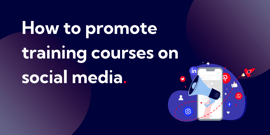How To Increase Your Online Course Bookings Using Email

In this modern world of increasing competition, your sales and marketing function needs to be operating at maximum capacity in order to stand out above the crowd, fill your training courses and grow your training company.
Increasing your online course bookings is certainly not easy. You’ve got all these valuable training courses on offer – but even for the largest organisations, raising awareness and spreading the word can often be a uphill battle.
If you sell training courses online but struggle with your course promotion, this guide offers some helpful tips on how you can best utilise the immense opportunity that is email marketing.
1. Introduction
2. Email Targeting
3. Writing The Perfect Email
4. Testing
5. The Benefits Of Email Automation Software
6. Final Considerations
1. Introduction
It’s easy to dismiss emails.
After all, everyone chats via instant messengers, younger generations use it less, and they’re heavily associated with spam.
But despite its perceived reputation, email remains one of the best content marketing tools to help sell more training. That’s because it adheres to one of the big marketing tenets out there: ‘Be where your audience is’.
Let’s not forget…
- Everyone has an email these days – it’s just not possible to navigate 21st century life without one
- It’s the cheapest way to target the most people – compared to other content marketing, emails keep your running costs low and offer the biggest ROI
- Most of your email contacts will be sourced from your website – meaning an existing target market willing and eager to be engaged
- It’s the preferred communication method between customers and businesses – according to Adobe, 63% prefer email marketing
So let's get you up and running...
In order to increase online bookings, you need to first build your email target list, create the perfect email, test it rigorously and implement email automation software.
2. Email Targeting
First and foremost, build your own target list.
Thinking of buying a list of email addresses?
Don’t.
For starters, those emails are likely worthless. Either these are dead addresses or you’ll be marketing courses to people who have little to no interest in the training you provide. Oh, and it’s an absolute no-no when it comes to GDPR. One of the biggest drawbacks of spamming to the masses is that it could also get your email server blacklisted. Yikes.
The best way to create a database of contacts is to build your own, from the ground up (oh, ensure that they opt-in to be contacted). This way, you can be sure that everyone you’re marketing your courses to is interested in what you’re offering. They signed up to receive your emails, after all.
This becomes your ready-made audience, eager to hear more. You can then nurture those relationships, segment your audience by demographics, and tailor your emails to what appeals to them.
3. Writing the email
From attracting new business to nurturing existing clients, you need to find the message that resonates with your prospects. It's never been more important to use both empathy and authority in your communications in order to build trust and show you care.
There is a great deal of research out there on how to craft the perfect sales email. Not surprisingly, a lot of this research overlaps and studies suggest there are 4 distinct areas you should both consider and remember for every email you write:
- An enticing subject
- KISS
- Drop the formality
- Use insight
Bonus
- Consider incentives
An enticing subject
As many as 47% of emails are opened based on the subject alone.
Nothing else matters if your prospect doesn't open the email in the first place. From my own experience, there’s 3 powerful keywords I want you to remember that will help to send your open rates skyward.
Scarcity – Nothing drives buyer behaviour quite like scarcity. If you’ve had X signups in X hours, shout about it! If you’re super busy, let prospects know! Discounts and promotions with cut-offs are great ways to encourage immediate action.
“WOW – 90% full in 24 hours”
We used the following graphic recently to encourage the last few signups for an event we were holding - safe to say, it worked a treat!
-1.png?width=1200&name=New%20Project%20(19)-1.png)
Curiosity – If you give too much away in the subject…what’s the point in opening it? Sometimes it’s good to arouse curiosity, or even be intentionally cryptic. HubSpot have a great article on this.
“How's next week looking?"
"Is this for you?"
Here at accessplanit, one of our most-opened and clicked sales emails is titled: Horses for Courses (and Resources!)
What is that about, you may ask? Curiosity got the email opened.
Personal – Simply by including the first name of the recipient in an email subject line can increase the click-through rate by up to 22.5%. Here are some other sales email statistics.
“Dave, let’s talk training!”
There are a number of other things you can try like including the mention of a video in the title which has proven results. There’s even research to say including emoji’s in your subject can increase open rates by up to 45%. Crazy.
Here are 55 examples of great cold subject lines, courtesy of Hunter.
KISS
“Keep it simple, stupid”
I’ve fallen into this trap more times than you could count. You think paragraphs of words detailing the extent of your training offering is going to entice people.
It’s not.
In this modern world of over-stimulation, busy schedules and short attention spans, you need to be direct. Your prospects don’t need to know what socks your trainer is going to be wearing on the day, they need to know quite simply:
- What it is you’re offering
- Why they should attend
It’s completely different if someone has asked for further information about your offering – that is a prompt for detail. Otherwise, KISS!
Try and avoid walls of text by using bullet points, with key messages in bold.
One other thing you MUST include is a Call to Action (CTA). This is all about prompting an immediate response. Whether it's to arrange a call, click a link, a direct reply or something else - make it known what you want from them!
Drop the formality
It's all about conversational and casual
It’s been ingrained in us since we sent across our very first curriculum vitae to an employer back in the day. It was expected that we should show the highest level of formality and politeness when sending an email, particularly to people we haven't met.
The reality is that people much prefer a laid back approach. One article from Entrepreneur says formal emails are actually far more likely to get deleted.
Being formal is common in early exchanges before rapport has been built. It's worth asking, if every email you're sending sounds formal, how strong is your relationship with the client?
Use insight
In a world of increasing competition, those templated, spammy emails have to go. Every single one of your prospects has a different challenge, different business objective, different budget and different requirements from you as a training organisation. For each of them to receive the same message trying to hook them in is nothing short of lazy and will not yield the results you seek.
So what’s the solution?
I’m not saying never to use templates, after all, 75% of the emails we send are never read. You could be wasting a great deal of time by crafting a personal novel for each client. But try to use at least one piece of insight unique to each client. This could be a follow up from a previous exchange, a compliment on an award or achievement, a comment some content they’ve posted or even something personal from their LinkedIn profile.
Consider Incentives
A great way to drive demand for your training is to bring something new to the table. Particularly if you're facing increased competition, it's imperative you use all the tools in your arsenal, including but not limited to:
Discounts & Promotions
Devaluing your offering should be used with caution. That said, there are a number of ways you can go about this. Perhaps offering retraining discounts, providing incentives for group bookings or new course promotions. The benefits of this is amplified if you’re using an eCommerce tool where delegates can input a discount code in the shopping basket. Self-serve success!

Value-adds
This could include things like access to an online content library or a learner portal, 1-to-1 coaching, printed certification, accommodation etc.
It's a fantastic way to offer something your competitors aren’t. Far too many providers offer a single day training session with all the course information digested in one day, with minimal or non-existent communication pre or post-course. Obviously, when you are looking to sell more training you have to go above and beyond!
In accessplanit's training management system, these upsells can be added to a training course your delegate is booking. Self-serve success!
Taster sessions
This can be as simple or as complex as you like. A simple tactic could be to record a training session and piece the best bits together for social sharing and promotion. More advanced taster sessions could involve bite size snippets that trainers deliver for free and even share some course material. Sales Geek are great at this. They provide so much value to their social following, without asking for anything in return. It works a treat.
So what does this look like when you bring it together?
Perhaps, a little something like this…
Subject: “Such an engaging, informative session. Loved it”
Hi NAME,
Firstly, a congratulations on winning a customer service award last week – well deserved I’m sure!
You may recall that I trained your staff on a 3-day IOSH course towards the end of last year. In fact, the subject of this email is what this relates to, it was some lovely feedback one of your staff left me!
My reason for contacting you NAME is that we’ve introduced a brand-new NEBOSH course, and I remembered you enquiring about the possibility to come back and retain with us.
We’d be delighted to come to your site and upskill your team. We’ve found ourselves busier than ever of late, but we’ve got a couple of options for availability.
When would be suitable for us to discuss this on a call? Would the 20th July work? Or would 15th August be better?
Look forward to hearing from you.
What do you see as the biggest improvement you can make to your sales emails? Let us know in the comments below.
4. Testing
Test, test, test… Then test some more.
The biggest bonus to harnessing email marketing is the ability to test your output against the results.
A few key things you need to track include:
- Open rates
- Click through rates
- Reply rates
- Conversions
You can continually modify and refine your messaging in order find a formula that works; hits the target; engages delegates; and drives sales. Conversely, you’ll be able to see, at a glance, what’s not working and what could ultimately be costing your organisation money – and act accordingly.
When it comes to your email marketing efforts, it’s a good idea to test absolutely everything. Subject lines, the copy, the offers, the design, the send date and time… You name it, if you can change it, try it. However, when you are A/B testing, it’s important to only make single changes – so focus on tweaking those subject lines, for instance, but retain identical copy. In doing so, you gain a clear overview of what changes make the most impact.
5. The benefits of email automation software
Of course, it takes time to craft the perfect email – one that gets opened and encourages increased online course bookings. Then you spend even more time selecting individual recipients. And then even more time running through the data to see what worked, what didn’t and where to make changes.
Thankfully, busy training companies can now take full advantage of email automation tools, like the one that comes packaged with our training management system. This software does everything from automatically populating fields (so no more typing out names by hand!) to anticipating upcoming award expirations and reminding delegates to rebook with you.
So, you can start reaping the benefits like…
- Saving time
The beauty of automated email marketing is the ability to set key trigger actions and let the software take care of the heavy lifting. So, for example, if you’re remarketing to existing delegates, you can command the software to only email those who booked a certain, similar course or contact those who haven’t been on your site for a set period of time.
- Precise targeting
You have untold amounts of data on your delegates. Now let your training software make the best use of it. Armed with all that information, automation means you can accurately target only those you want to target – this means you won’t waste time contacting those who don’t want the courses you’re offering. Instead, you can segment your audience based on a variety of factors and target them individually with personalised emails relevant to them.
- Standardised branding
Automated email tools allow you to create branded, standardised templates that keep your emails looking just as they should. Alongside the obvious peace-of-mind this brings, as you confidently send another mail-out, it also ensures that your email marketing communications remain professional at all times. Oh, and it also means the end of worrying about fiddly issues like formatting.
6. Final considerations
Be GDPR savvy
On May 25th 2018, the EU’s General Data Protection Regulations directive came into force. This beefed-up iteration of the Data Protection Act offers new rights and protections for EU citizens and British subjects (yes, even after Brexit). These individual rights include…
- The right to be informed – You must tell delegates when you’re collecting their data, and your lawful basis for doing so, e.g. because they’ve signed up for a course and need to receive email updates.
- The right to be forgotten – If a delegate requests you take them off your mailing list, or opts out of certain workflows, you are legally obliged to comply.
- The right of access – Your delegates can request to see all the data you hold on them.
Meanwhile, any business collecting, processing and storing personal and sensitive data will find increased liabilities and responsibilities (not to mention increased non-compliance fines, up to £20 million or 4% of global turnover).
Conclusion
If you're looking to sell more training using email, the above steps should provide a solid foundation to help get you started on your first campaign. Once up and running, you need to be continually updating, testing and changing in order to find what resonates. Got any other top email tips? Let us know in the comments!
Ready to automate your email marketing? Get in touch with our team to book your free demo and discover how our training management software can help you increase online course bookings.



